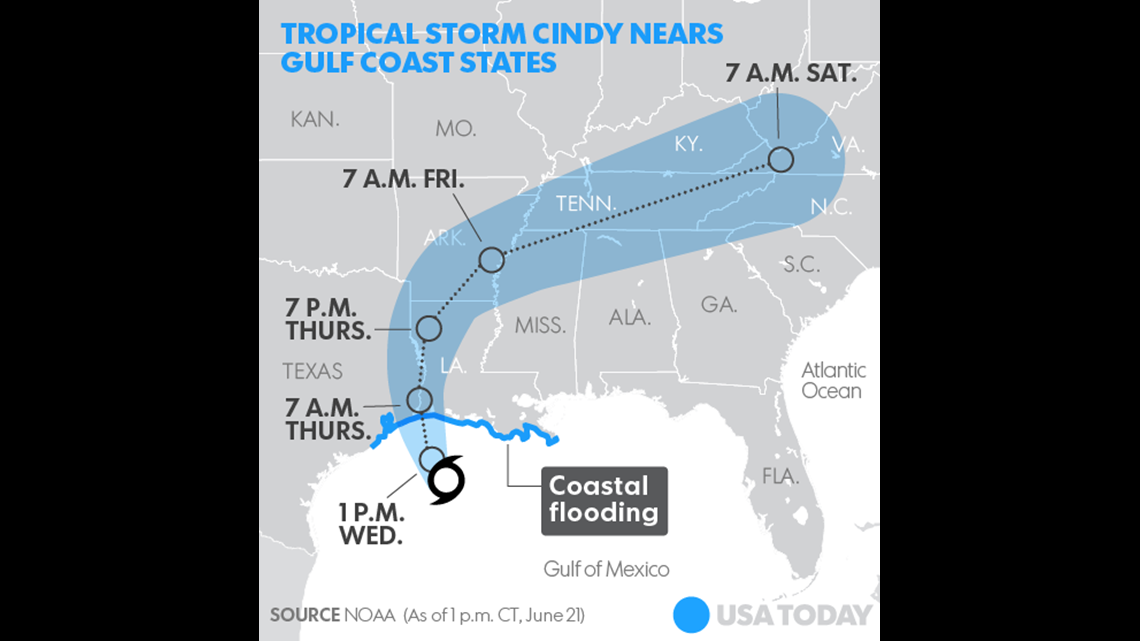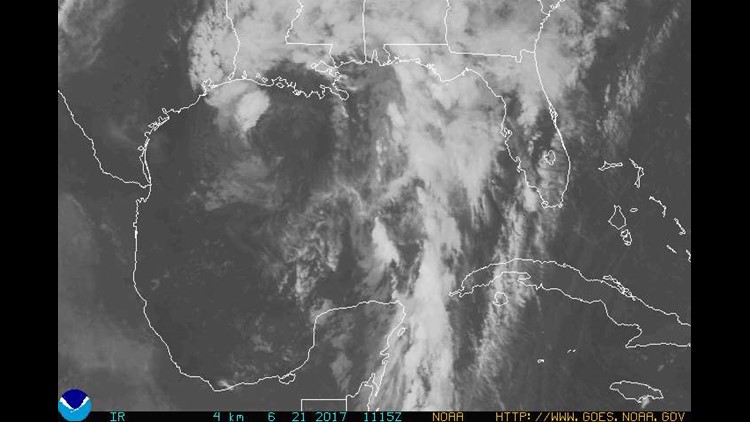Tropical Storm Cindy has made landfall in southwestern Louisiana, bringing rain and the threat of flash flooding and tornadoes.
As of about 4 a.m. CDT Thursday, the storm was centered about 30 miles (48 kilometers) west-southwest of Lake Charles, Louisiana, and is moving north near 12 mph (19 kph).
The U.S. National Hurricane Center says Cindy's maximum sustained winds have decreased to near 40 mph (64 kph) with continued weakening expected over the next two days.
On Bolivar Peninsula. So far SH 87 is all clear. Tune in to #khou We are checking it out! pic.twitter.com/L7luf7kiur
— Sherry The Wise (@SherryKHOU) June 22, 2017
Louisiana Gov. John Bel Edwards declared a state of emergency on Wednesday as a 10-year-old boy died in Alabama. Parts of Louisiana had five inches of rain by early afternoon, and Pensacola was slammed by more than 8 inches of rain in 36 hours.
And more was on the way.
Cindy, armed with sustained winds of 45 mph, was expected to generate up to 15 inches of rain over southeastern Louisiana, southern Mississippi, southern Alabama and parts of the Florida Panhandle through Thursday night, and a few tornadoes also were possible, according to the National Weather Service.
The storm could produce "life-threatening flash floods along the central Gulf Coast," the agency said.
Flooding and power outages were already reported early Wednesday, almost a full day before the storm was forecast to make landfall. A tropical storm warning was in effect from San Luis Pass, Texas, to the mouth of the Mississippi River.
The White House said President Trump was briefed Wednesday on the storm.
There was some good news Wednesday when the National Weather Service lifted the tropical storm warning for metropolitan New Orleans. But Mayor Mitch Landrieu urged residents not to be complacent as parts of the city were hit with five inches of rain by midday.
"Just because we're not in the cone for this storm doesn't mean we're not going to continue to feel the impact from TS #Cindy," Landrieu tweeted.
Some streets in the city were closed because of flooding, and Landrieu asked residents to clean out catch basins — and not to drive through standing water. Landrieu said the city could expect an additional 3-6 inches of rain by midday Friday. And tornadoes were also a possibility.
“The state’s emergency preparedness and response apparatus are taking Tropical Storm Cindy seriously, and we are calling on all Louisianans throughout the state to do so as well,” Edwards said. "Please do all you can to prepare for the worst while praying for the best.”
AccuWeather meteorologist Dan Kottlowski said Cindy, which formed Tuesday, was moving slowly because it was trapped between a strong high pressure system blamed for blazing heat in the Southwest and another strong high over the Atlantic.
Kottlowski said the worst problem will be inland flooding, an issue that could continue into the weekend as the storm makes its way into Tennessee and beyond.
In Louisiana, the Federal Emergency Management Agency was moving 125,000 meals and 200,000 bottles of water into the state. The Louisiana National Guard moved high water vehicles and helicopters into areas that could potentially flood.
Flood control locks and gates were being closed along Louisiana’s coast. Flooding was also reported on Alabama’s Dauphin Island. Power outages were reported in Morgan City and flooding was reported in parts of St. Mary's Parish.
In St. Mary's, Sheriff Mark Hebert made rounds to insure residents were safe, whether they were fleeing or staying put. Most people were likely going to leave, Hebert said, as he inspected the area around Cypremort Point on Vermilion Bay.
"A few are hurrying to get out of here," he said, a flooded parking lot behind him.
We've learned not to be complacent during storms. We're being prepared and measured here during TS #Cindy
— Mitch Landrieu (@MayorLandrieu) June 21, 2017
In Alabama, Governor Kay Ivey also declared a statewide emergency, citing National Weather Service forecasts for significant flash flooding in the state.
In Texas, Gov. Greg Abbott ordered the State Operations Center to upgrade to "increased readiness." Abbott activated four Texas Task Force 1 boat squads and two Texas Military Department vehicle squads of five vehicles each to respond to any emergencies. The Department of State Health Services Emergency Medical Task Force, Texas Military Forces Aircraft and shelter and feeding teams were placed on standby.
“As we have learned in the past, weather patterns can change rapidly and without warning," he said. "I ask all Texans to keep those in the storm’s path, and our brave first responders, in their prayers as they prepare for this storm.”
In Galveston County, Texas, voluntary evacuations were underway for the Bolivar Peninsula for people with medical conditions that depend on electricity.
In Florida, John Dosh is director of emergency management for Escambia County, where Pensacola is the county seat. He said the drainage system had reached capacity Wednesday and encouraged residents in flood-prone areas to closely monitor conditions. But he hoped the flooding could be minimized.
"There are a lot of variables including how fast the rain falls," he said. "If it doesn't fall too fast, we might be able to squeak through."
At East Hill Hardware & Supply in Pensacola, Bill Scott shrugged off the rain.
“I was told that there is gonna be storm, but there is only rain which is pretty normal here," Scott said. “We are used to hurricanes."
Contributing: Waseem Abbasi, USA TODAY; Melissa Nelson Gabriel, Pensacola News Journal; The (Lafayette, La.,) Daily Advertiser; KHOU TV (Houston); Melanie Eversley, USA TODAY. Associated Press





